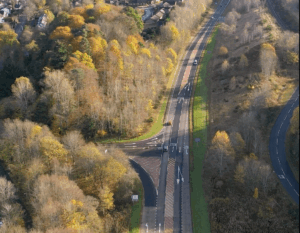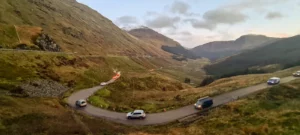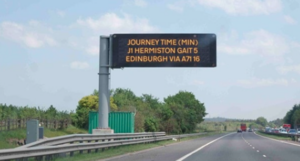Low Emission Zones have now been formally introduced across Edinburgh, Glasgow, Dundee and Aberdeen.
Plans have been agreed at the local authority level and have now also been approved by Scottish Ministers, as required in legislation through the Transport (Scotland) Act 2019.
With the shape and scope of LEZs now agreed across the four cities through this introduction, local grace periods until enforcement commences have now begun.
- In Glasgow, the LEZ already applies to buses. For other vehicle types, enforcement commences on 1 June 2023 (1 June 2024 for residents within the zone)
- Edinburgh will commence enforcement on 1 June 2024
- Dundee will commence enforcement on 30 May 2024
- Aberdeen will commence enforcement on 1 June 2024
LEZs set an emissions limit for certain road spaces, restricting access for the most polluting vehicles to improve air quality. This helps protect public health within our towns and cities, making them more attractive places in which to live, work and to visit. LEZs also encourage people to think about leaving the car at home and to consider public transport or active travel – supporting climate action by helping to meet Scotland’s world leading commitment to reduce car kilometres travelled by 20% by 2030.
Vehicles that do not meet the emission standards set for a Low Emission Zone will not be able to drive within the zone. A penalty charge will be payable by the registered keeper of a vehicle when a non-compliant vehicle enters the LEZ.
The minimum emission standards for vehicles permitted within the four LEZs are:
- Euro 4 for petrol cars and vans (generally vehicles registered from January 2006)
- Euro 6 for diesel cars and vans (generally vehicles registered from September 2015)
A number of vehicles are exempt from LEZ requirements, including any vehicle driven by a blue badge holder. Funding remains available to help people and businesses that need it most to comply with Low Emission Zones. Full information is available at www.lowemissionzones.scot
The introduction of Scotland’s LEZs marks the completion of the Scottish Government’s landmark Programme for Government commitment. Welcoming the introduction, Minister for Transport Jenny Gilruth said: “The introduction of Low Emission Zones is a truly significant public health moment for Scotland. Our air quality is generally good – but for too long air pollution has exceeded legal limits for health in our city centres as a consequence of unrestricted vehicle emissions.
“We have a moral responsibility to act. Air pollution often disproportionally impacts those with the least in our society. It causes the most damage to the youngest, the oldest and those with pre-existing medical conditions.
“LEZs are the biggest change we’ve ever seen in how vehicles will access our cities – and they need to be, in order to best protect public health and improve air quality.
“With a year to go until the earliest point of enforcement in Glasgow and two years to go until enforcement in Edinburgh, Dundee and Aberdeen, I encourage everyone to visit www.lowemissionzones.scot to find out more about the schemes, including the Scottish Government funding on offer.”
Councillor Scott Arthur, Transport and Environment Convener, the City of Edinburgh Council said: “By introducing an LEZ, Edinburgh is joining cities right across the UK in working towards a healthier environment and a better quality of life for everyone. We all have the right to breathe clean air and it’s our responsibility to tackle air pollution to protect the health and wellbeing of the most vulnerable members of society.
“The LEZ will restrict the most polluting vehicles from entering the boundary, reducing harmful traffic-related nitrogen oxide emissions by a predicted 55% in the zone.
“The LEZ is one of a number of tools to reduce harmful emissions and is being delivered alongside a range of projects to support sustainable travel, including Edinburgh City Centre Transformation, Trams to Newhaven and City Centre West to East Link. Together, these will help achieve our vision of a clean, green and net zero European Capital.”
Joseph Carter, Head of Devolved Nations at Asthma+Lung UK said:
“Air pollution is the biggest environmental threat to public health. It is causing new lung conditions like lung cancer and worsening existing ones. With 1 in 5 Scots developing a lung conditions like asthma and COPD in their lifetime, for them, it can trigger life-threatening asthma attacks and exacerbations.
“Children’s lungs are also more susceptible to air pollution as they are still growing, and they also breathe faster than adults. As they grow, toxic air can stunt the growth of their lungs, making them less resilient into adulthood and placing them at greater risk of lung disease in the future. More than 70,000 children have asthma in Scotland and for them, peaks in toxic air can put them at risk of a potentially life-threatening attack.
“The gradual roll out of Low Emission Zones is going to be a huge step forward to start tackling this major health problem. Starting in Glasgow in 2018 and then extended to our core cities with the Transport Act 2019, LEZs are one of the most effective way of reducing pollution.”
John Bynorth, who leads Scotland’s Clean Air Day for Environmental Protection Scotland said: “We welcome the milestone introduction of LEZs to Scotland’s four main cities as it will lead to vast improvements in air quality in the city centres where the zones operate. Outwith the LEZs, we would also expect to see potential benefits to the surrounding areas as people consider their travel options and consider cycling or walking instead of taking the car.
“This will lead to improvements in the health of people who live, work and go to school in these cities and make them cleaner and more sustainable as they strive to achieve net-zero climate change targets in the coming years.”
Neil Leckie, Senior Programme Manager at the Energy Saving Trust said: “The expansion of Low Emission Zones in Scotland’s major cities will play a key role in improving air quality and in the transition to a net zero carbon society. The zones will encourage the use of low carbon transport and active travel, and available funding to prepare for the changes will support the individuals and businesses who need it most – including additional support for taxi drivers.
“We look forward to continuing to work closely with Transport Scotland to shape the future of low carbon cities and sustainable travel in Scotland as part of our commitment to address climate change.”
(Picture – Transport Scotland)






















